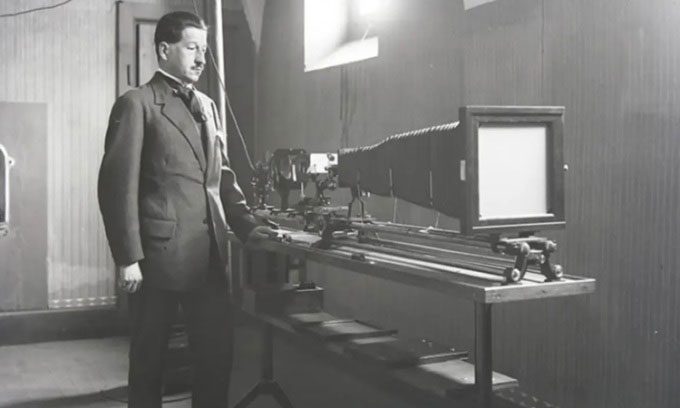Edmond Locard, known as the Sherlock Holmes of France, established the world’s first forensic laboratory in Lyon.

Edmond Locard using a photographic device in the 1920s. (Photo: Lyon Archives)
In 2005, a collection of over 20,000 glass plates was discovered in a garage in the city of Lyon, France. At that time, authorities lacked the budget to restore the photographs. Funding from a local historian in 2017 helped preserve and digitize over two-thirds of this collection. The results revealed the world’s first investigative laboratory, established in 1910 by the pioneer of forensic science, Edmond Locard, who is often referred to as the Sherlock Holmes of France, as reported by Interesting Engineering on April 8.
Today, going to the crime scene and piecing together clues to reconstruct the sequence of events is a common practice in investigations. However, a century ago, police did not investigate cases as they do now. Handwriting analysis was considered an advanced technique, and it was through this that Locard began his forensic career.
Locard’s mentor was Alphonse Bertillon, who invented a method of identifying individuals using body measurements. However, when a Jewish officer was accused of espionage, Bertillon was invited as an expert in handwriting analysis, despite having no experience in this field. Bertillon’s erroneous testimony contributed to the infamous scandal known as the Dreyfus Affair within the police force. This event also motivated Locard to establish a laboratory where fingerprints, blood samples, hair, dust, and pollen could be scientifically analyzed to serve as evidence in court.
The collection of glass plates from the laboratory was housed in the garage of the National Forensic Police in Ecully, Lyon, until 2005. Although transferred to city archives, these plates continued to deteriorate over the following decade due to a lack of resources. By 2017, a thin layer of gelatin on the photographs had become moldy. It wasn’t until historian Nicolas Delestre, who specializes in burial customs, provided financial assistance that the restoration of these photographs began. The images were digitized and completed in the spring of 2018, coinciding with the publication of a biography about Locard.
To date, the published photographs showcase Locard’s team working with equipment and conducting experiments. One of their methods for identifying individuals involved classifying body tattoos. Locard drew inspiration from the Lumière brothers, pioneers in cinematography, and Arthur Conan Doyle, the creator of the character Sherlock Holmes. Throughout his life, Locard also ceased using certain techniques, such as handwriting analysis, as he deemed the results unreliable. Locard’s forensic research from over a century ago continues to inspire today’s professionals. Detailed descriptions of Locard’s forensic laboratory photographs have been shared in the journal Nature.


















































